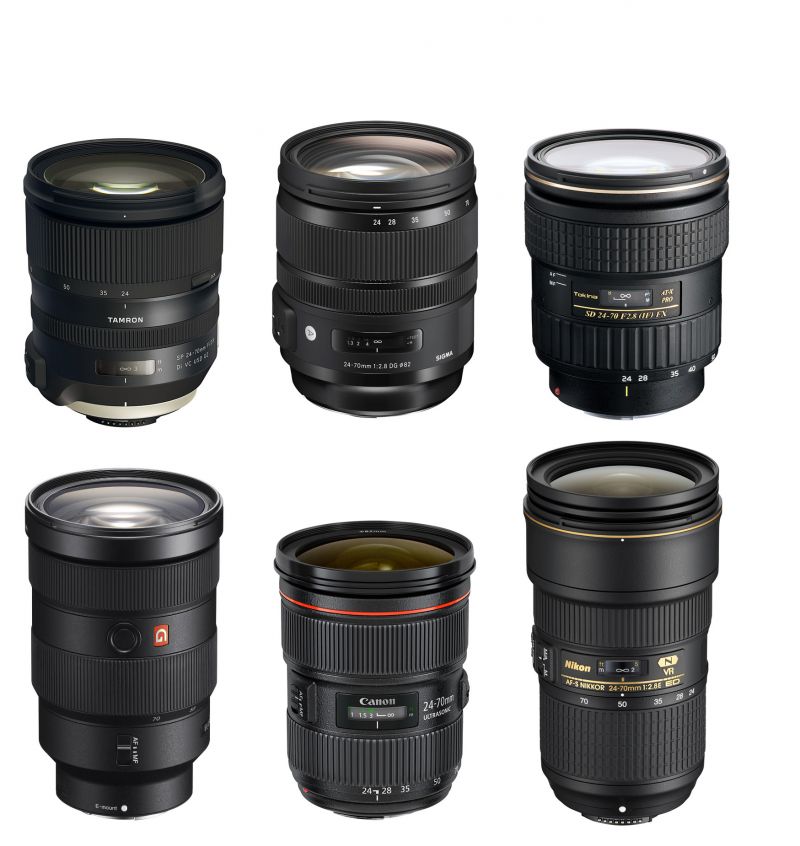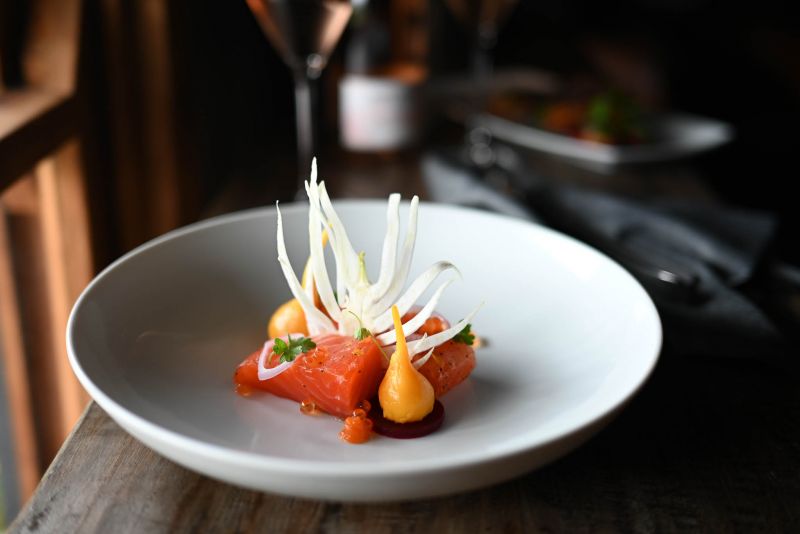
Food photography has always provided some of the most enticing imagery. It resonates with us so strongly because it appeals to one of our most primal needs; the need to feed. Today, with such a wide array of outlets for your photography, you may find yourself in need of a few different perspectives to display the next culinary masterpiece plated on the other side of your lens. In this article, we’ll give present to you the best lenses for food photography.
Note: The lenses listed below are all for full frame cameras. Additionally, the prices listed are current as of February 2024.
Mid-Telephoto Macro Lenses
You could have guessed this lens would make the list. (Honestly, however, DO NOT just stop reading here and buy one of these! A macro lens isn’t the end-all solution for all food photography; it is merely our “easy” recommendation, a good starting point.)
Macro lenses are famed for their sharpness and close focusing ability, in both stills and video. Some of the options below include image stabilization, making them well suited to produce smooth video should you need to shoot handheld. Generally speaking, of course, food photography is best done from a tripod, so don’t hesitate to also purchase an older, un-stabilized model.
Autofocus is in the same category of features: It’s very nice to have, however, it is entirely possible to generate a full-time income from food photography using an old manual focus macro lens! Especially with today’s manual focusing aides on mirrorless cameras; it is easier now more than ever to nail focus, as well as depth of field, using live view and doing everything manuallly…
Best Macro Lenses For Food Photography

- Canon RF 100mm Macro f/2.8 L Macro IS – $1,099 (Read our full review here!)
- Nikon 105mm f/2.8 – $946
- Sony 90mm f/2.8 Macro G OSS – $1,098
- Panasonic Lumix S 100mm f/2.8 Macro (Sigma/Leica L mount) – $997
- Sigma 105mm f/2.8 DG DN Macro Art (Sony E, Sigma/Leica L mount) $799
- Olympus (OM System) M.Zuiko Digital ED 90mm f/3.5 Macro IS Pro Lens – $1.499
- Tamron 90mm Macro f2.8 – $649
- HD Pentax-D FA Macro 100mm f/2.8ED AW – $546
Again, remember that these are simply the best, latest macro lenses in the ~100mm focal range. If you want the most versatile option that has autofocus, and maybe even optical stabilization in some cases, get one of these. HOWEVER, don’t hesitate to also consider any older versions of any of these lenses, as they’re all still extremely sharp and will work wonders even when using an adapter on a modern mirrorless camera!
Is the 100mm is the best lens for food photography?

Things like water droplets on ingredients, or the way food glistens are well-captured with a 1 to 1 macro lens. By showing them life-size, you can draw the viewer to the food….
But, honestly? A 100mm macro may be an easy go-to lens at first, but it’s not necessarily the end-all, be-all lens, either. This is because 100mm forces you to “keep your distance” from your subject, and it also introduces a significant amount of shallow depth of field (background blur) that can sometimes be excessive.
If you want to entice your viewers to want to experience the food, to actually want to eat it, one effective trick is to literally just get closer to those juicy details! (There is a difference between just “zooming in”, and physically bringing your lens closer to the subject! This difference actually makes viewers FEEL closer to the subject.)
For this reason,
24-70mm f/2.8 Zoom Lenses For Food Photography

Versatility is the name of the game with any 24-70mm, and especially if it offers an f/2.8 aperture. Simply put, if you can only get one lens to do all sorts of photography, for stills and/or video, this will cover your food photography as well as almost every other genre of photography out there!
The latest lenses are generally the best, because they have great autofocus, excellent close-up magnification and sharpness, and in some cases, optical stabilization…
- Canon RF 24-70mm f/2.8L IS – $2,099
- Nikon Z Nikkor 24-70mm f/2.8 S – $2,096
- Sony FE 24-70mm f/2.8 GM II – $2,298
- Olympus 12-40mm f/2.8 PRO II – $999
- Sigma 24-70mm f/2.8 DG DN Art – $1,099
Tilt-Shift Macro Lenses For Food Photography

This recommendation is for dedicated, likely full-time professional food photographers only! Whereas a 24-70mm f/2.8 lens is an excellent all-around lens that can do almost anything, a tilt-shift lens is truly an exotic specialty lens that is designed for one purpose only.
That purpose is, of course, to allow users to modify their plane of focus so that it TILTS to cover an entire subject. This is a particularly difficult challenge in food photography, because you are always going to be working up-close at macro or near-macro magnification factors, and you are often going to want to have every important detail be perfectly tack-sharp! (While also still blurring the background, too!)
A tilt-shift lens is the ultimate tool for food photography, especially if you are working an studio environment where you can control the background to minimize distractions.
Unfortunately, very few dedicated tilt-shift (and macro-capable) lenses exist; there are a few excellent ones from Canon and Nikon, and a couple not-so-excellent options for those who are truly on a tight budget and only looking to “experiment” with tilt-shift photography…
- Canon TS-E 50mm f/2.8 L Macro Tilt Shift – $2,199
- Canon TS-E 90mm f/2.8 L Macro Tilt-Shit – $2,199
- Nikon PC-E Micro-Nikkor 85mm f/2.8 D Tilt-Shift – $1,976
- AstrHori 85mm f/2.8 Macro Tilt (Nikon Z, Canon RF, Sony E, Sigma/Panasonic/Leica L) – $329
- TTArtisan Tilt 50mm f/1.4 Lens (Nikon Z, Canon RF, Sony E, Sigma/Panasonic/Leica L) – $199
NOTE: All tilt-shift lenses do not have autofocus, they are all-manual lenses! Also, those last two, the AstrHori and TTArtisan lenses, are TILT-ONLY; they do not offer shift capability. (This is fine for food photography, usually; shift features are more useful on wide-angle lenses for real estate and architectural photography.)
50mm Prime Lenses For Food Photography

Believe it or not, but the most standard prime lens actually allows you to create beautiful food photos! You get separation from your background, tack-sharp details, and a nice medium-close effect with more than enough magnification for larger dishes, plates, etc.
However, when choosing a lens, the wider your aperture opens the wider your wallet will as well. If you are a portrait photographer then you already know this; the good news is that for food photography you don’t actually want such ultra-fast apertures; because of how much depth of field you’ll want for these types of lenses, an f/1.8 prime or even up to f/2.8 is excellent, too!
- Canon RF50mm f/1.2 L – $1,299 (Full review here!)
- Nikon Z 50mm f/1.2 S – $1,596.95 (Full review here!)
- Sony FE 50mm f/1.2 GM – $1,398 (Full review here!)
- Sigma 50mm f1.4 Art – $849
- Fujifilm XF 33mm f/1.4 R LM WR – $799
F/1.8-F/2.8 Alternatives
NOTE: Unlike macro lenses, we do recommend sticking with one of these modern, latest-and-greatest ~50mm prime lenses. This is for multiple reasons, but mainly, older 50mm lenses usually don’t have as good macro capability, both in terms of magnification and sharpness. Also, a “nifty fifty” is such an all-around photography lens that you usually want the best, latest version of autofocus technology, and don’t want to have to use an adapter, either.
24mm & 35mm Wide Angle Prime Lenses For Food Photography
If you want to get even closer, and bring your viewers an “in your face” perspective on your food photos, then a wider prime will give you the perspective you need. While a 24-70mm f/2.8 type lens would be an easier, more well-rounded choice, a wide-angle prime can give beautiful results with its faster aperture. This could be excellent if you are not only a food photographer but also a content creator who does cooking tutorials, recipe demos, or any similar type of content.
- Canon RF 35mm f/1.8 Macro IS STM – $499
- Nikon Z 35mm f/1.8 S – $846
- Sony FE 35mm f/1.8 – $748
- Olympus (OM System) M.Zuiko Digital ED 20mm f1.4 PRO – $699
- Panasonic Lumix S 35mm f/1.8 – $597
- Sigma 35mm f/2 DG DN Contemporary (Sony E, Sigma/Panasonic/Leica L mount) – $639
- Fujifilm XF 23mm f/1.4 LM WR – $899
85mm Prime Lenses For Food Photography
Although we would generally recommend a dedicated macro lens in the 100mm range if you are primarily a food photographer, there is a very good chance that you do a lot of different types of photography, and you’re looking for a more versatile lens. In that case, we have saved some of the best news for last! An 85mm prime is an ultimate all-around medium-telephoto lens. It can easily double as a workhorse portrait lens, and yet also do close-up details of food or anything else very effectively.
- Canon RF 85mm f/1.8 IS STM Macro – $599
- Nikon Z 85mm f/1.8 S – $696
- Sony 85mm f/1.8 – $598
- Panasonic Lumix S 85mm f/1.8 – $597
- Fujifilm XF 56mm f/1.2 R WR – $899
Conclusion
When first building a photography kit, versatility is key. You’ll want to start your gear collection with pieces that will offer the most bang for the buck. Of course, what you need will depend on the types of photography in which you specialize. If your niche happens to be food photography, we hope this article has helped you determine the best lens for food photography.
Matthew Saville
Follow his wilderness nightscape adventures on Instagram: instagram.com/astrolandscapes





Get Connected!